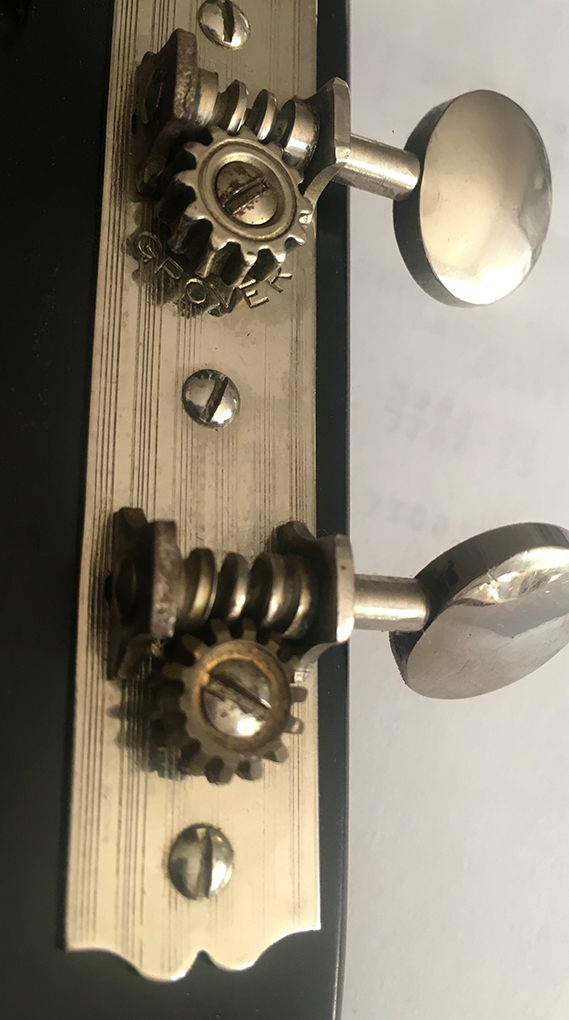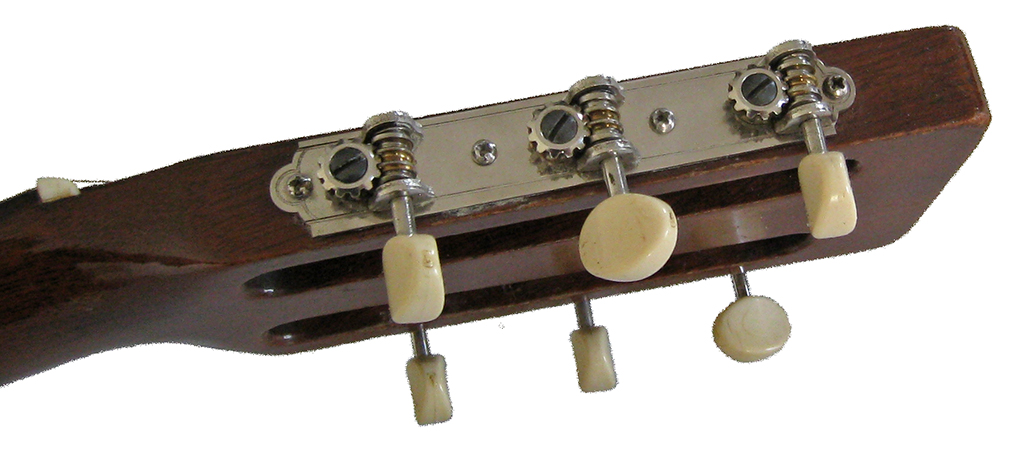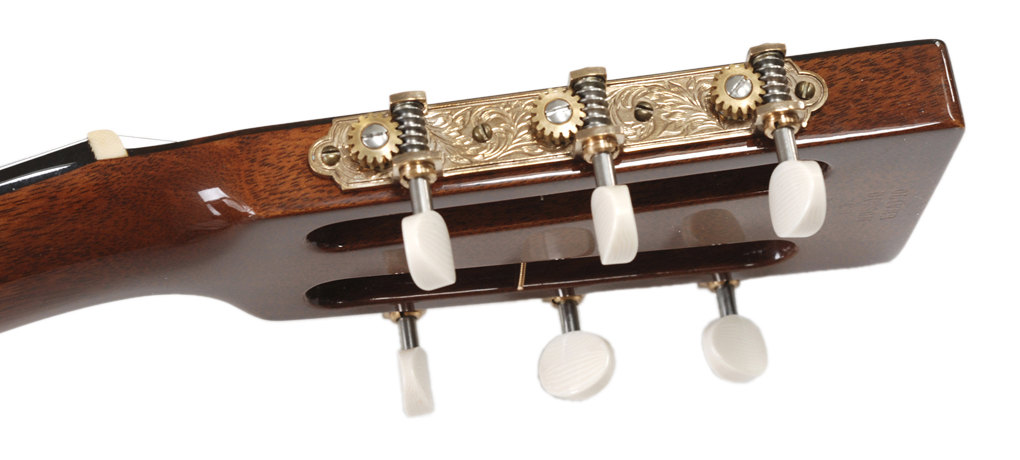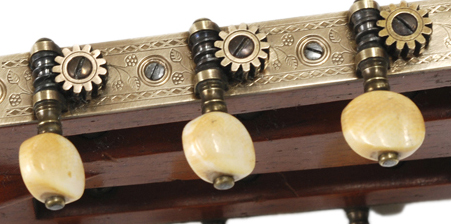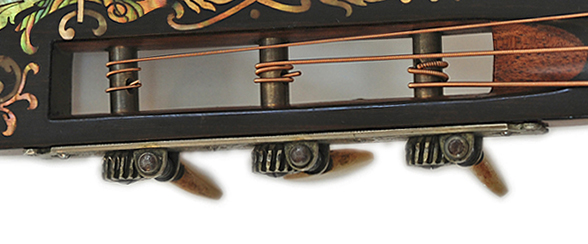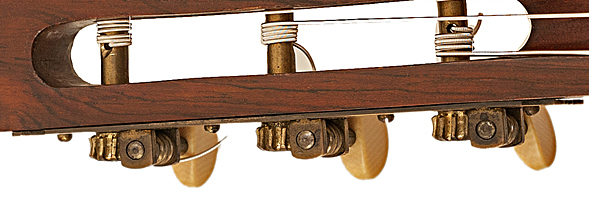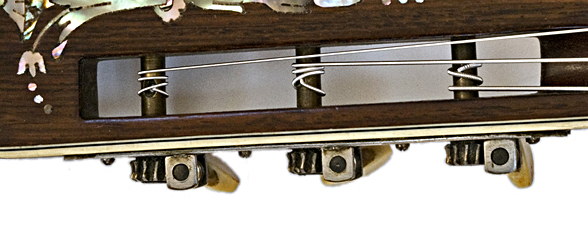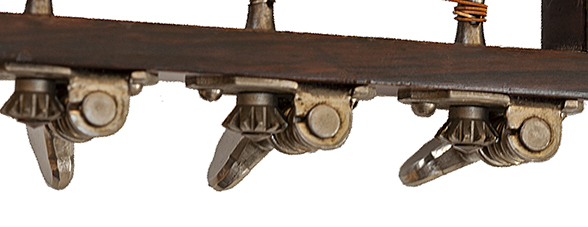Tuners on 12 fret C. F. Martin Guitars
Martin guitars produced from 1833 to 1929, with necks built with 12 frets clear of the body, generally have one of three styles of tuners: enclosed tuners on a Stauffer style headstock, ebony or ivory pegs on a solid headstock, or geared machines designed to fit a slotted style headstock.
Stauffer Style Gears
The earliest guitars built by C. F. Martin had a headstock in the style of the guitars built by his mentor, Johann Stauffer, which utilised gears enclosed by a metal plate, with six tuning pegs in a row on one side of the headstock, a feature which was later borrowed by the Fender Company. Martin imported these gears, which were a major expense, comprising a significant portion of the cost of thse early guitars.
c. 1820's Guitar attributed to Johann Stauffer
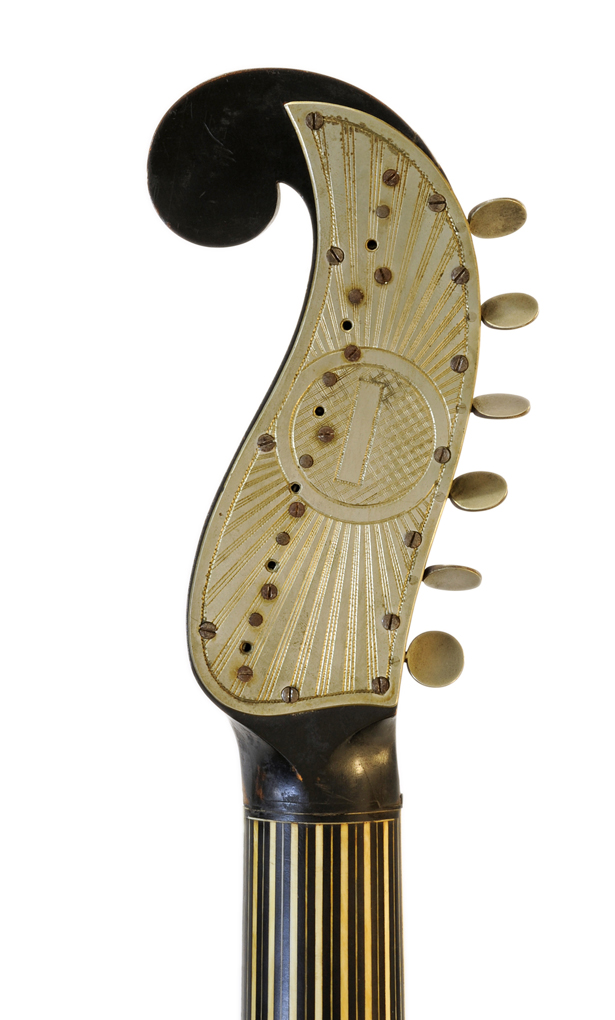
Martin & Coupa Koa
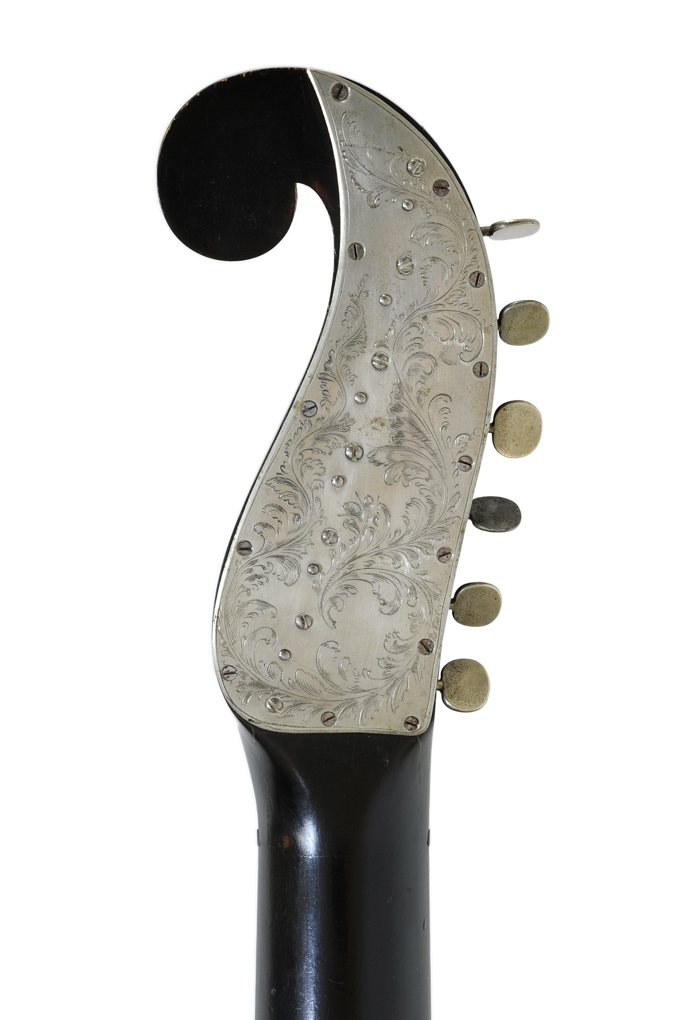
Martin & Coupa Spanish
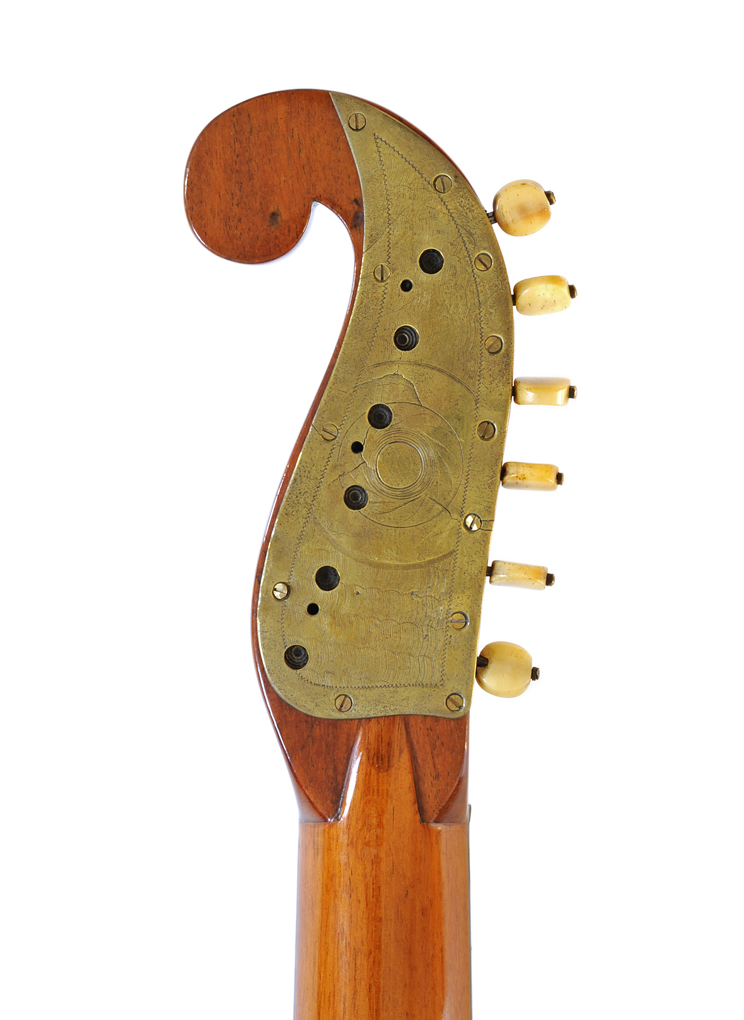
1840's Ivory Fingerboard Spanish Martin
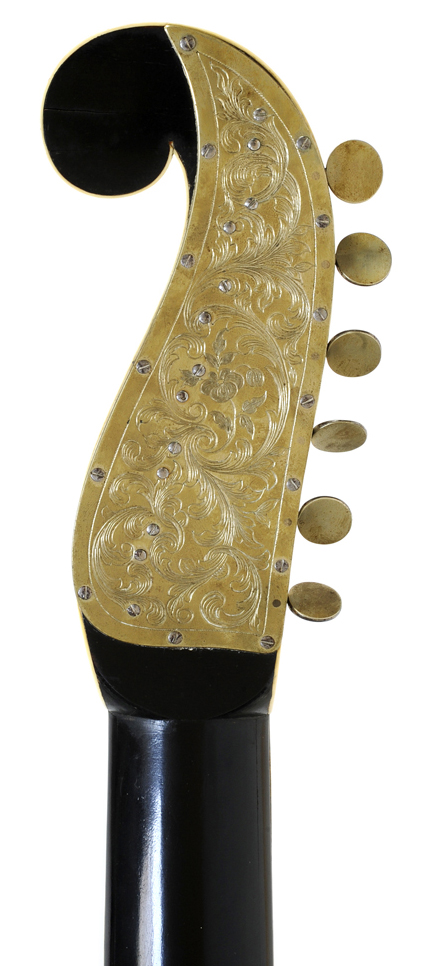
Martin soon developed a flat headstock which is similar in shape to the headstock seen on Martins to this day. These early headstocks sported ebony or ivory pegs. The ivory pegs would remain an option into the early 20th century.
Ebony and Ivory Pegs
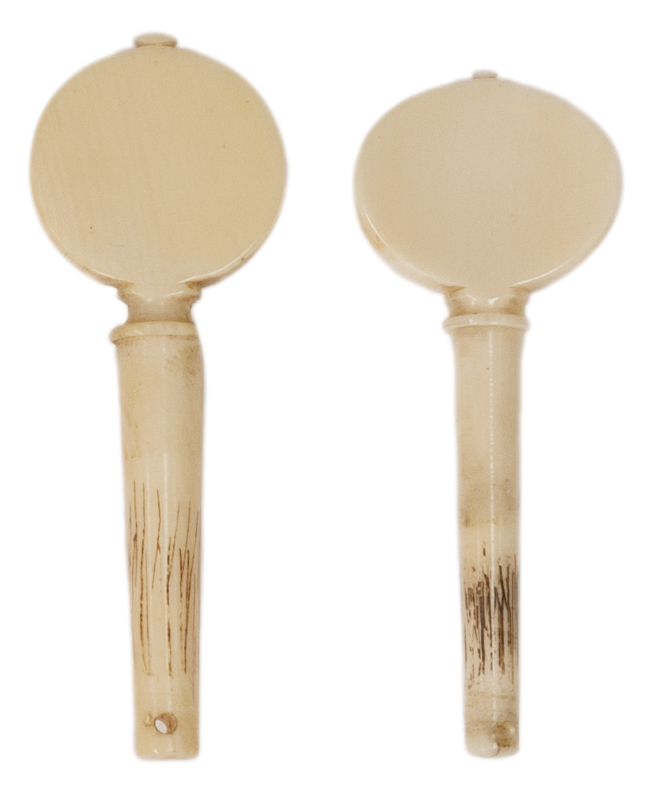
1840's Martin "Spanish Style" Guitar
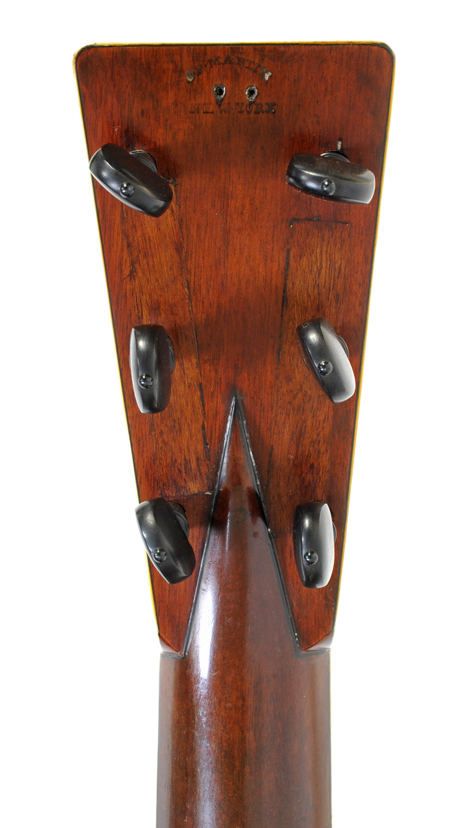
Ivory pegs vary in shape, with earlier buttons that are round and later buttons that are oval, and later 19th Century pegs that are not quite symmetrically round or oval but tapering slightly toward the peg inserted into the headstock.
This photo is actual size on a 1920x1200 display.

1840 "Renaissance" Martin, 1840's 1-21 zig-zag Martin, 1867 Martin 0-34, 1870's Martin 2 1/2 - 26, 1880's Martin 1-21, 1888 Martin 2-24, 1894 Martin 0-42, 1896 Martin 2-42, 1899 Martin 1-28.

Earlier pegs were more consistent in thickness, with later pegs tapering to a thin edge at the top of the button.
Most, but not all ivory pegs, have a small decorative element on the top of the button, which varies from one to the other in size and shape, usually carved from the ivory, but some in black, or abalone, as on this 1840's "Renaissance" Martin.
1840's Martin "Renaissance" Guitar
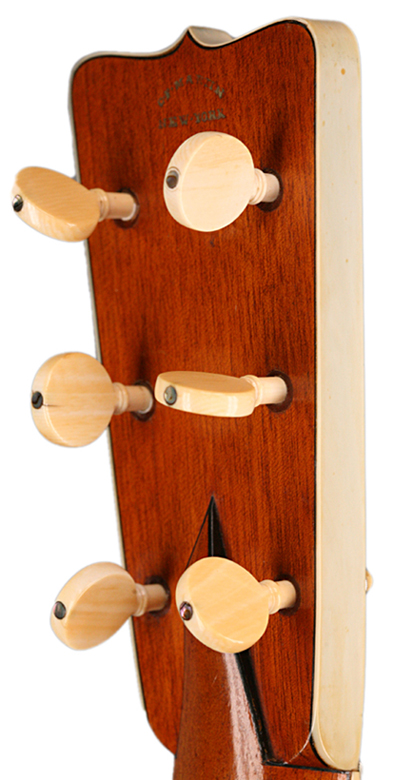
This Martin & Coupa has
unusual ebony tuner buttons with pearl on the end of the post
that shows from the front of the headstock.
Martin & Coupa
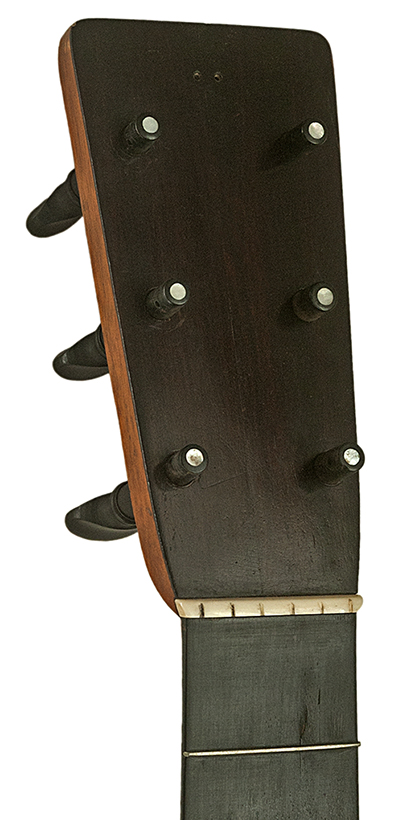
1894 Martin 0-42
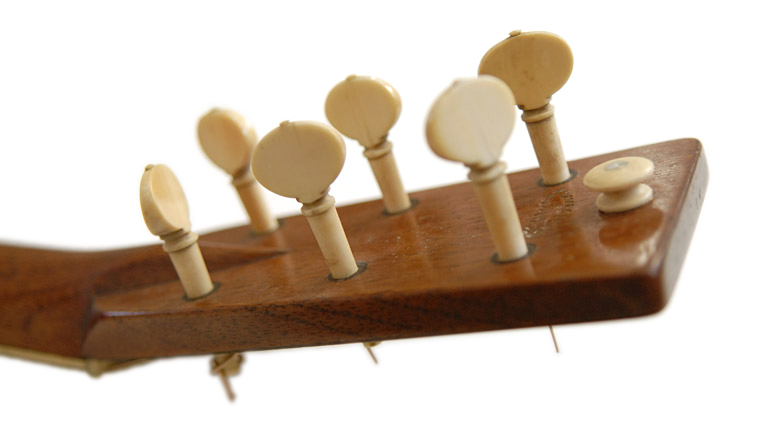
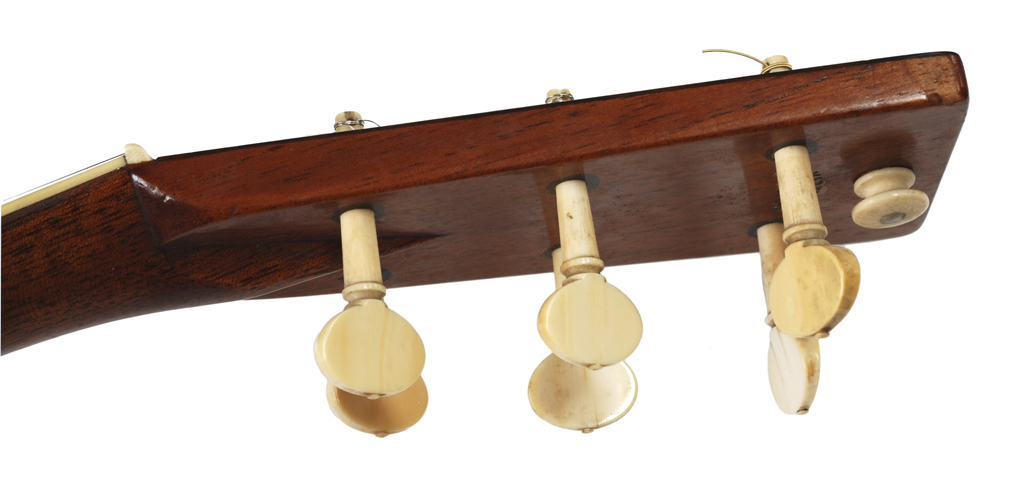
1870's Martin 2 1/2 - 26
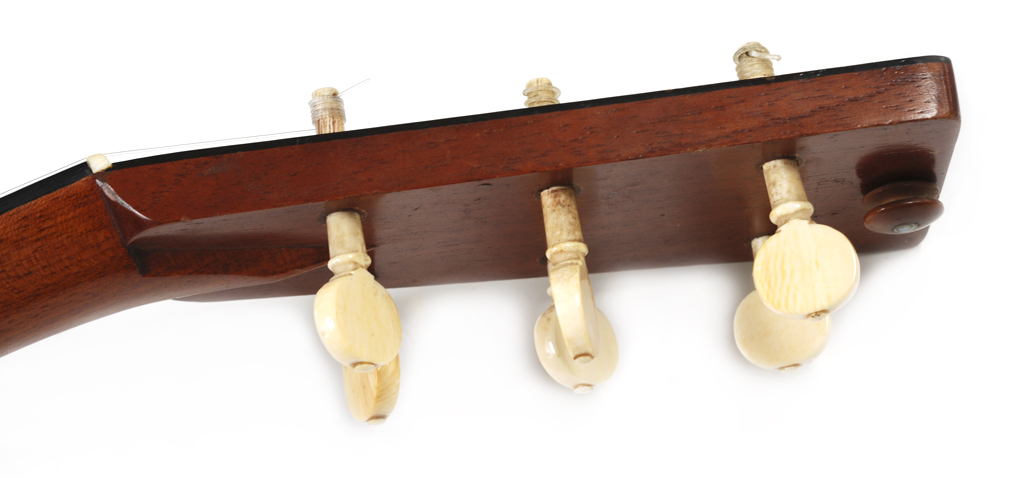
c. 1867 Martin 0-34
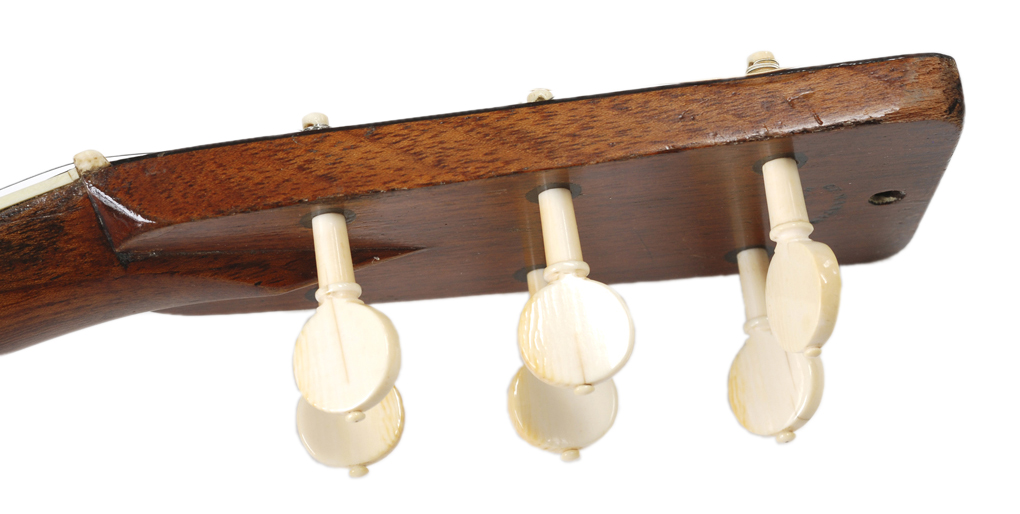
1896 Martin 2 1/2 - 42
You can see here that one peg has been replaced by another which is rounder, with a larger decorative element on the top.

1899 Martin 1-28
This set of ivory pegs has three with small white decorative elements on the buttons, and three with flush black dots. It is quite possible that this set is all original to the guitar, with Martin having used pegs from two different batches, as the size and shape of the buttons are quite similar.
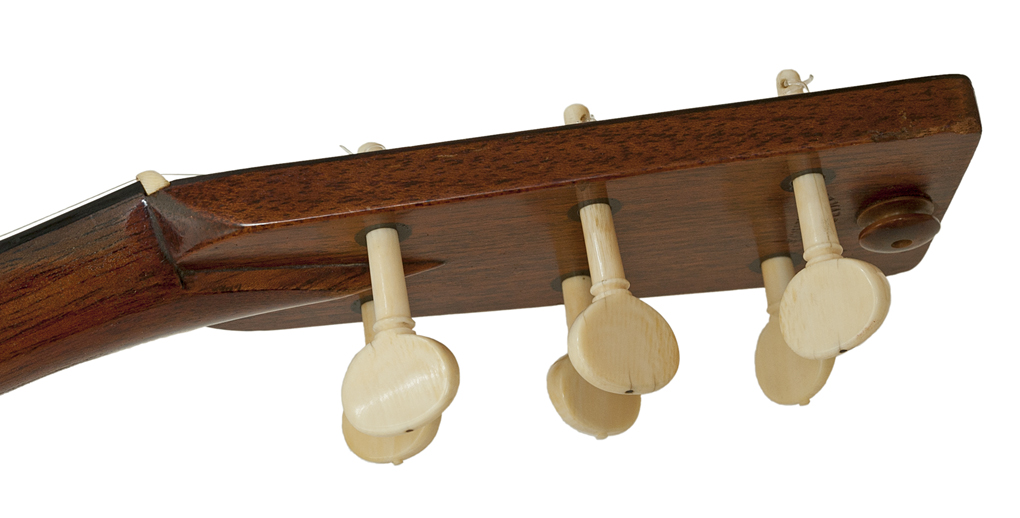
12 Fret Gears
By the 1850's, most Martins used geared tuning machines, the first of which bore the name "Jerome".
Martin 1860 2-24 with Jerome tuners
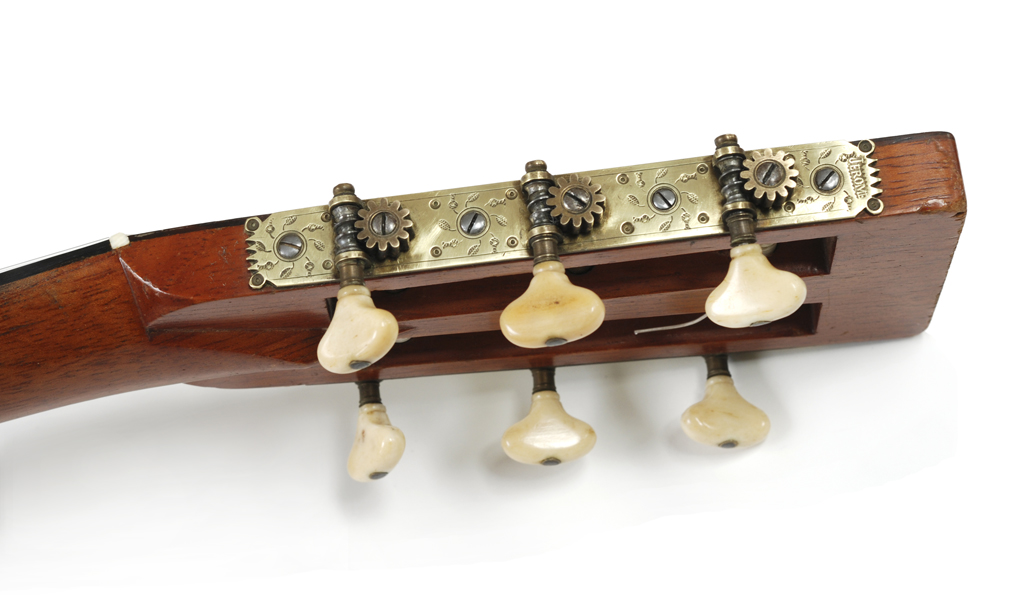
While Jerome tuners with bone buttons appear on the earliest Martins, these rare large bone rollers appear on only the earliest Jerome tuners.
1840's Spanish Style Alternate X Brace Martin Guitar
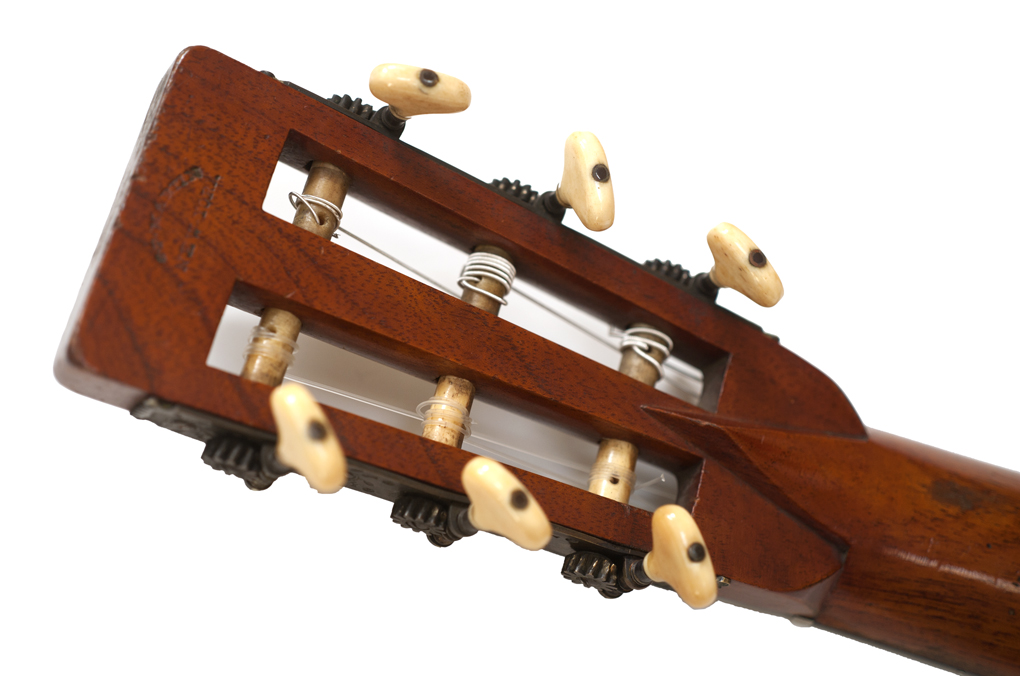
The very earliest Jerome tuners also have what I call "barrel" gears, with a flat round top, in addition to the bone rollers.
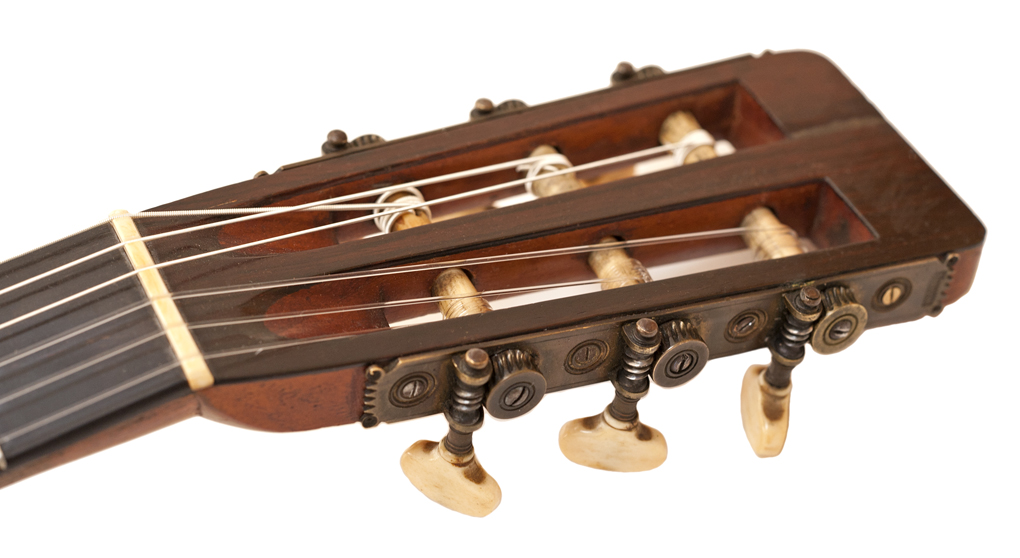
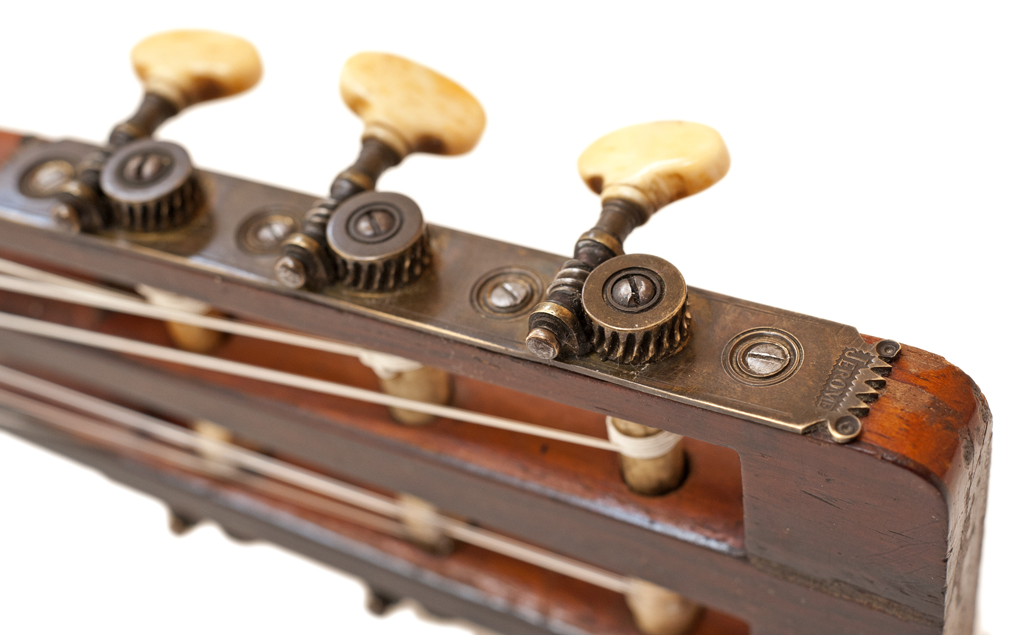
On finer early Martins, Jerome tuners are sometimes also seen with fancier, ornate carved pearl buttons.
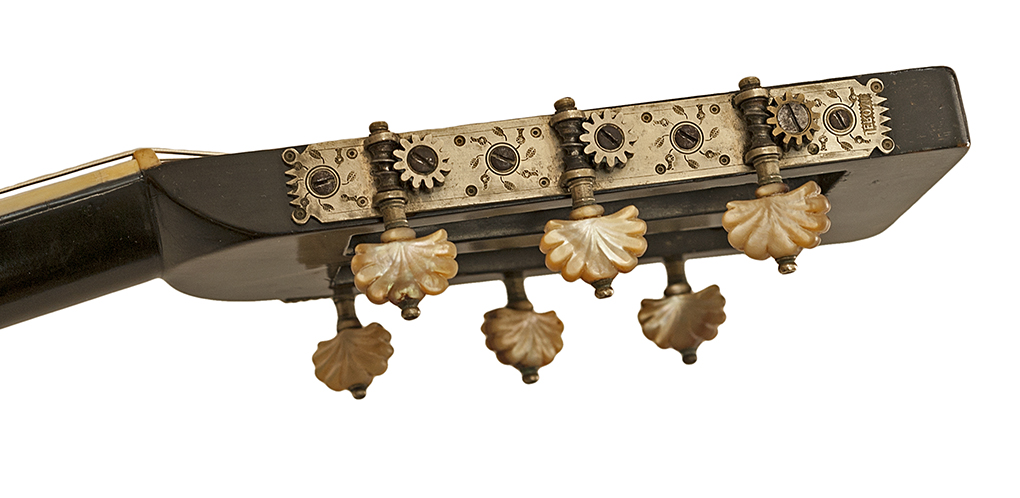
The 19th Century Tuners, also with thick, heavy gears, made after the Jeromes are said to have been made by Seidel
Martin 1870's 1-26
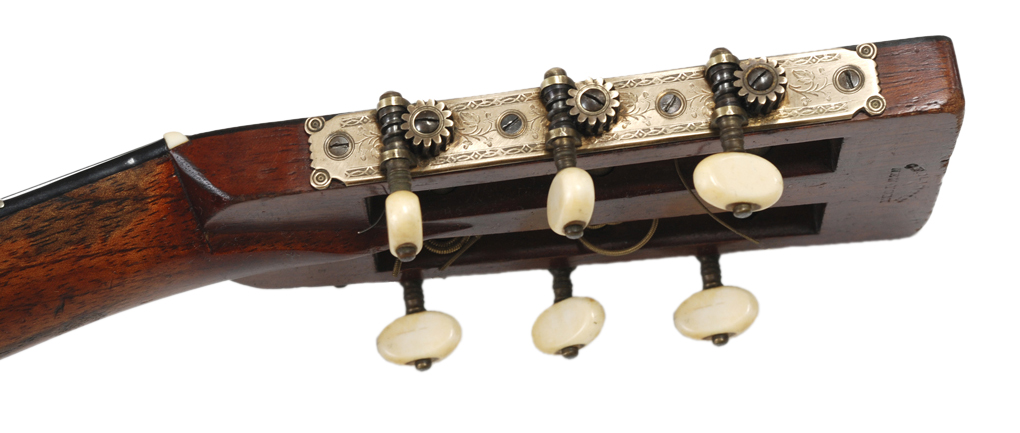
Martin 1870's 1-28
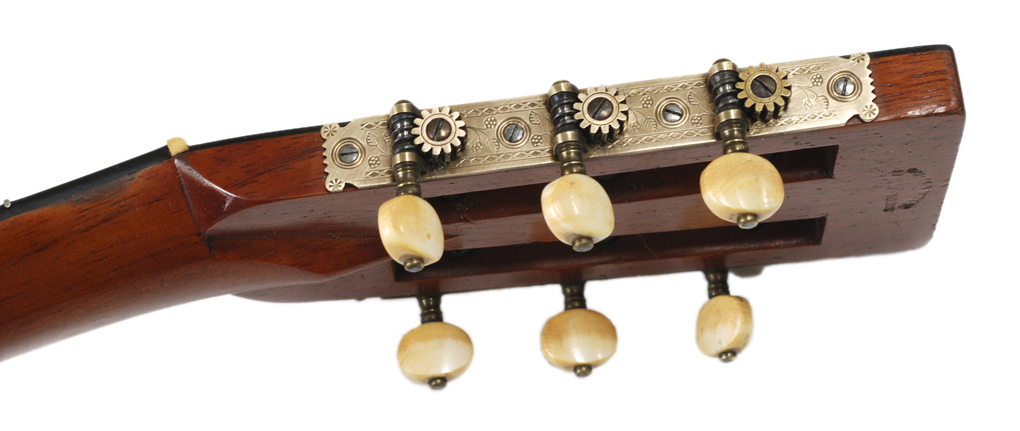
Martin 1870's 0-40
This tuner, generally seen only on the uncommon Style 40, is perhaps the most exquisite tuner seen on a Martin, featuring silver "Teddy Bear" style plates, and pearl buttons. It is not known who made these beautiful tuners.
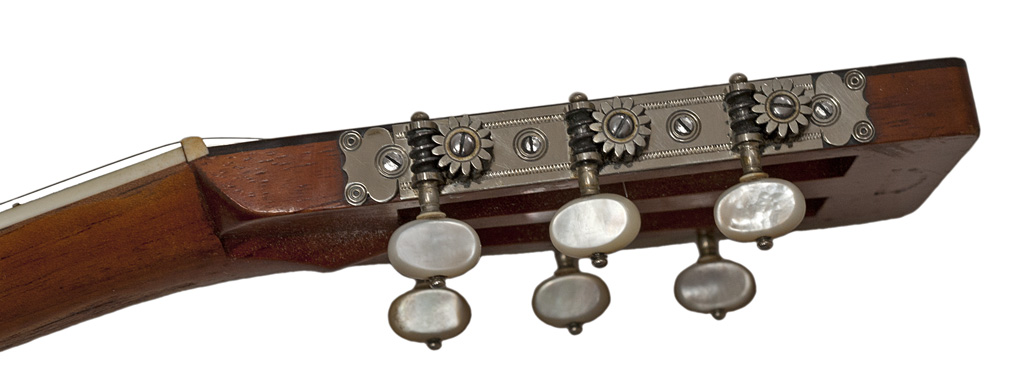
Martin 1870's 2-27
I can't say who made these unusual tuners that appear on some of the Style 2-27. These are reminiscent of the shape of a beautiful silver tuner that appeared on the early Style 40.
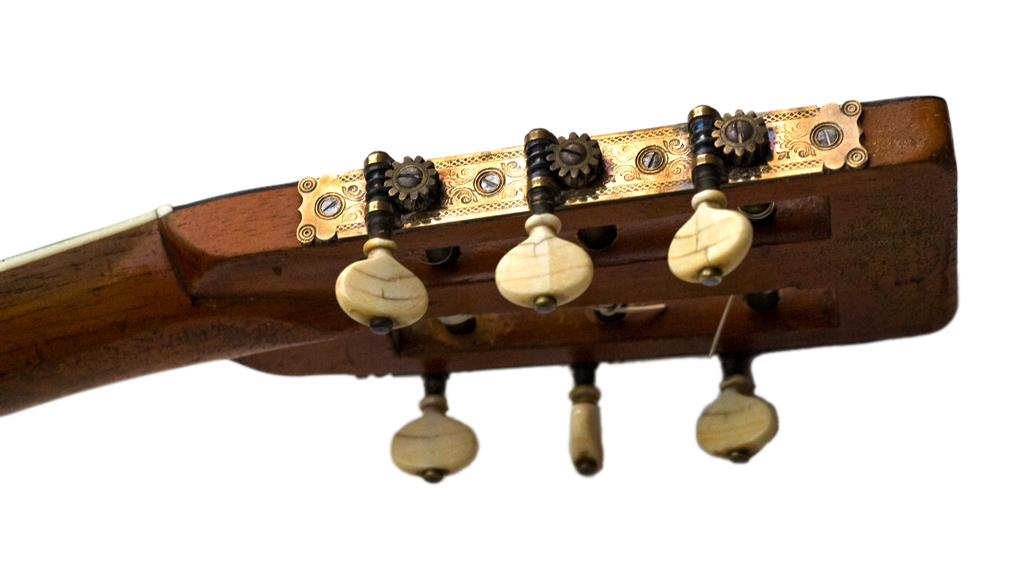
This is another uncommon tuner style that shows ups here on an unusual 1874 Martin with pearl buttons.
1874 Martin 1-28
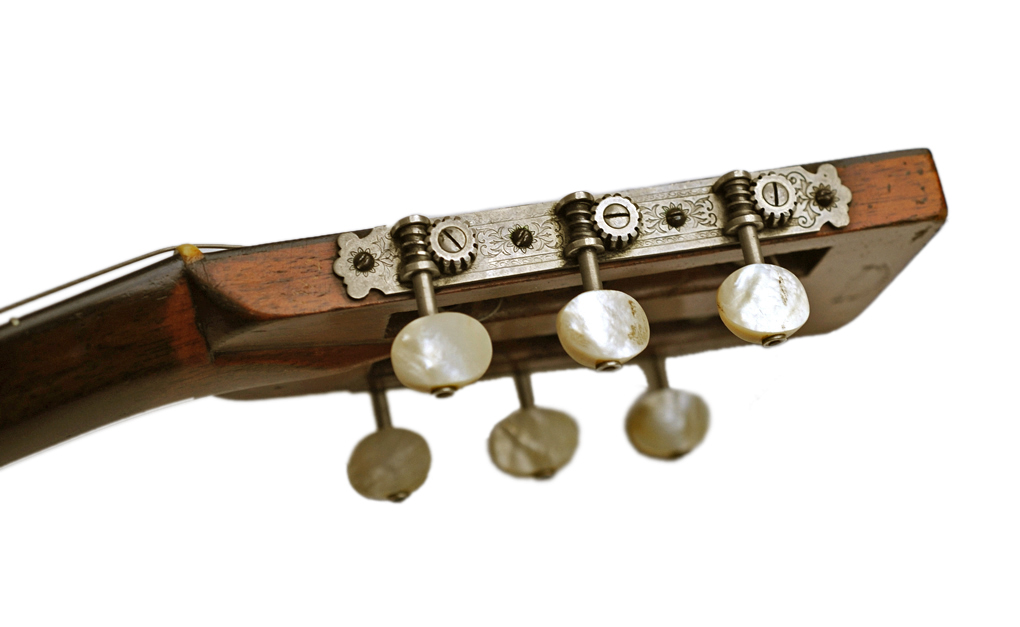
These three on a plate 12 fret tuners show that Martin used the Seidel style tuners with concentric circles on the corners at least through 1897.
Martin 1897 1-21
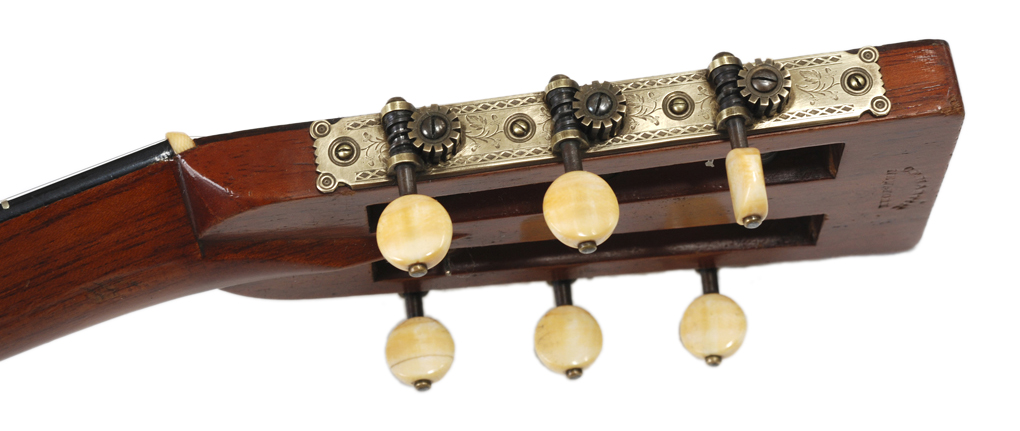
This 1902 Style 00-42 prototype for the Style 45, with pearl buttons, shows that the Seidel Style tuners with imprinted corners and those with concentric circles were used contemporaneously through the years.
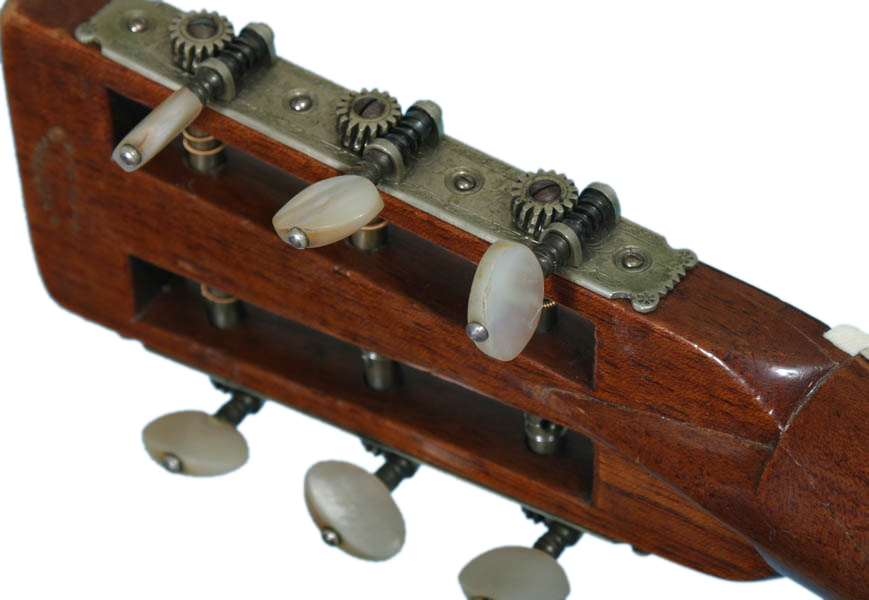
These three on a plate 12 fret tuners with saw tooth ends and rounded "Mickey Mouse" corners, beveled gears, and an early engraved design were made by Waverly.
A number of high end guitars and mandolins, seen often through the teens, were shipped with Waverly tuners with beautiful fancy buttons produced by Handel.
These tuners show that the Waverly tuners replaced the Seidels between 1902 and 1905, and were seen on most Martins until 1924.
1905 00-42S
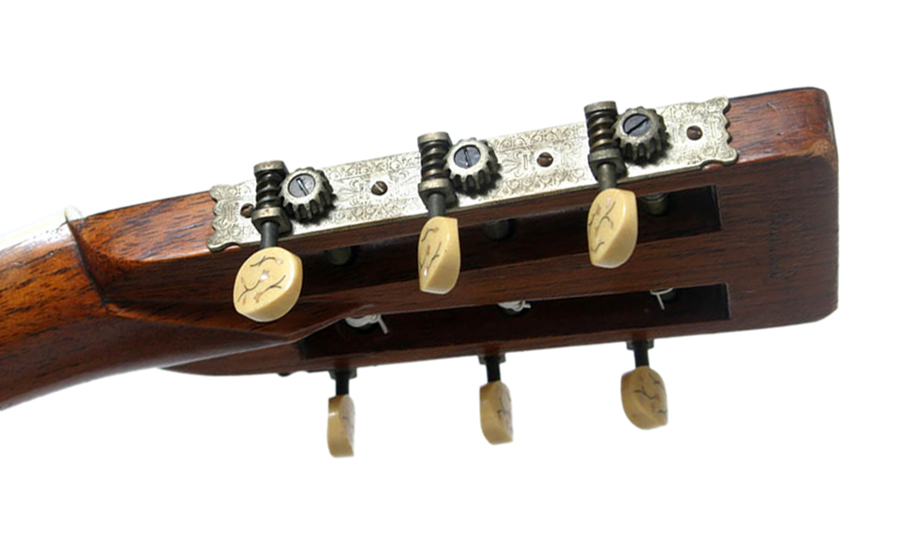
These three on a plate 12 fret tuners with saw tooth ends and rounded "Mickey Mouse" corners made by Waverly have the common "Irish Rose" floral design.
Martin 1907 1-28
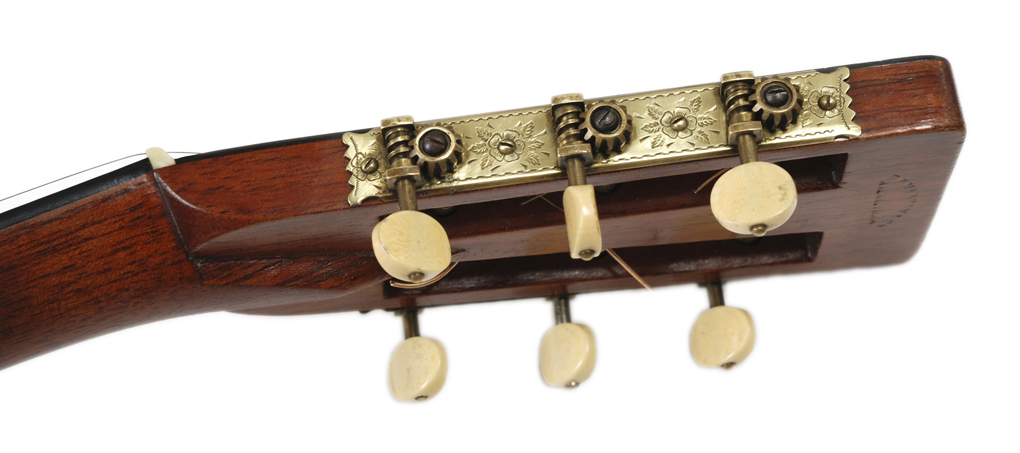
These Waverlys combine the fleur-de lis pattern with one version of the double hatched lines that would be seen often on Waverlys for many years.
Martin "Nunes" 1917 Style 1400
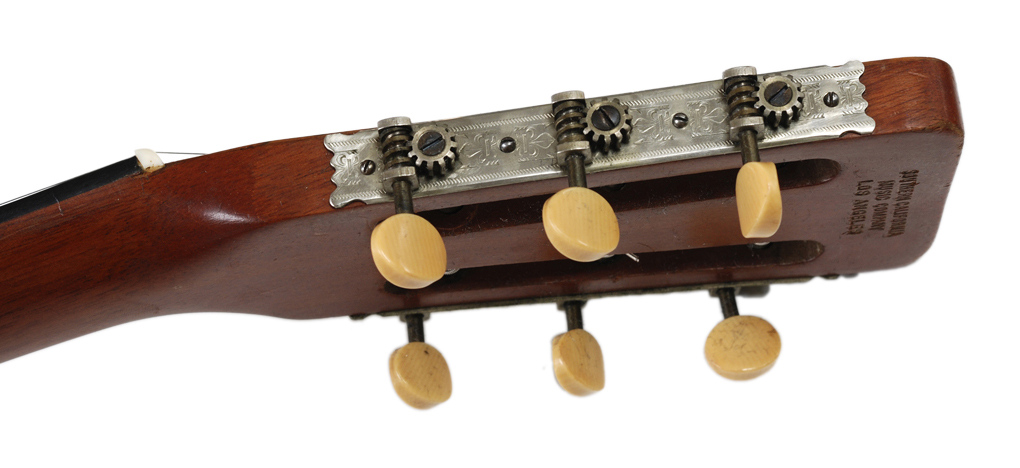
Martin 1917 0-30
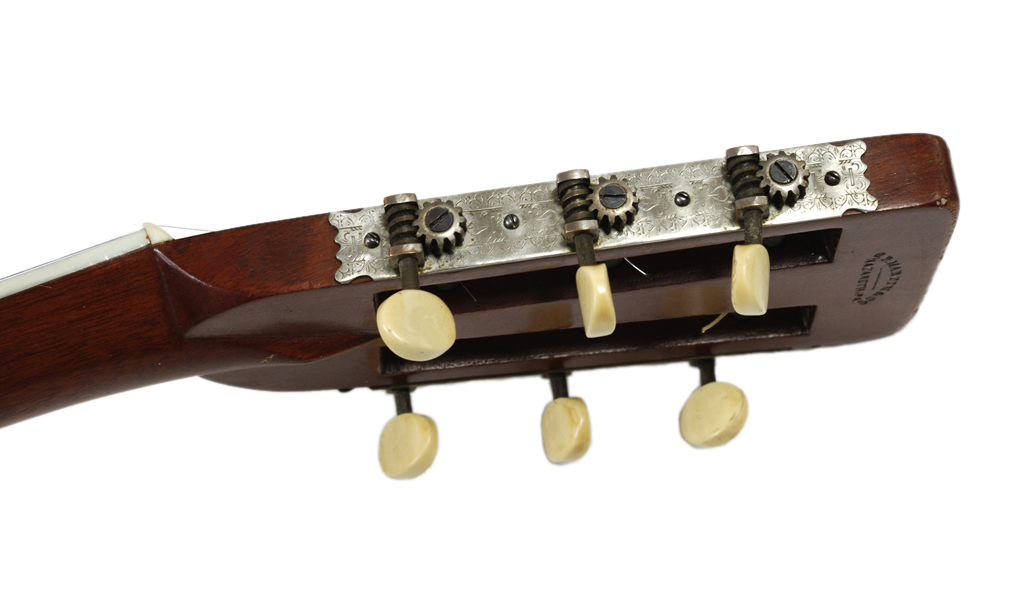
A plainer brass version of the Waverly tuner, with simple hatched lines, was used on less expensive Martins.
1916 Ditson Style 22
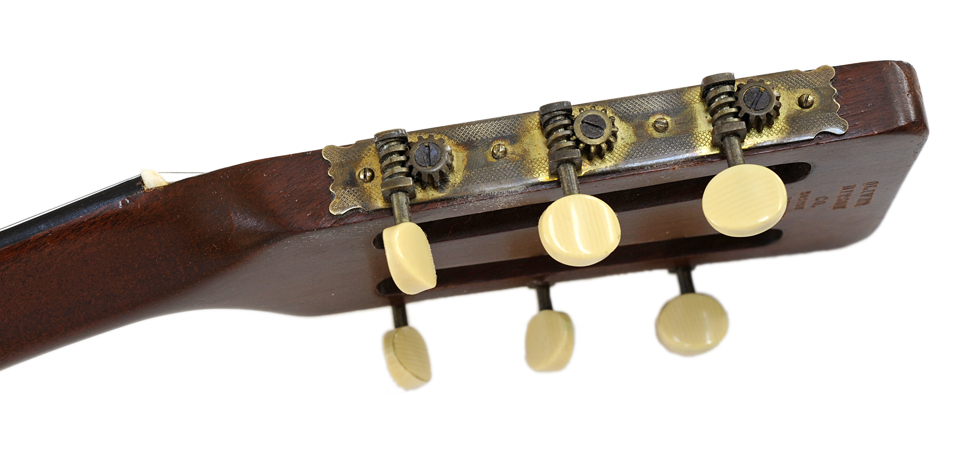
1913 Martin Foden Special Style E
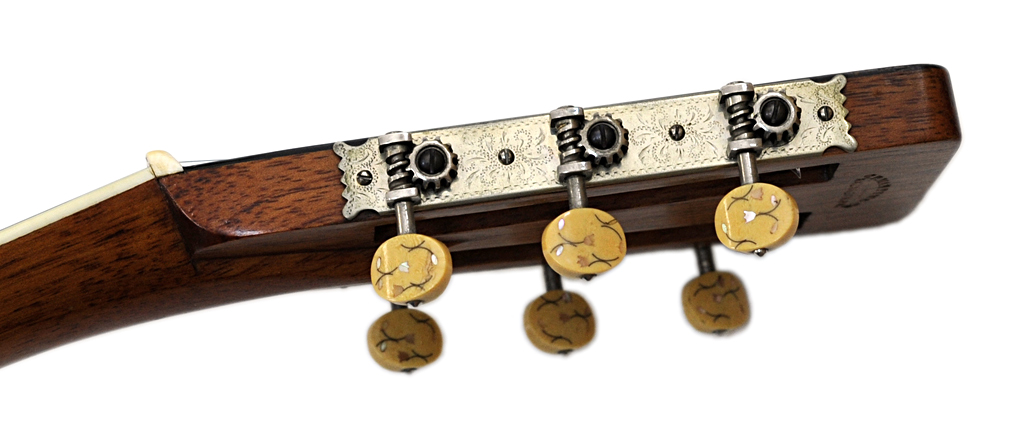
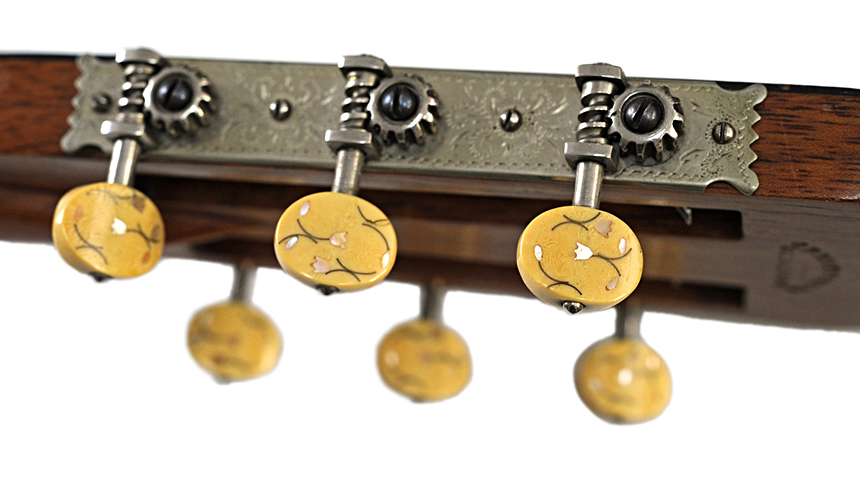
These tuners, most likely made by Waverly, are seen on some Style 18 guitars in the mid 1920's.
This basic design was also seen contemporaneously on the Lloyd Loar era Gibsons.
1923 Martin spruce top S.S. Stewart 0-17 Special
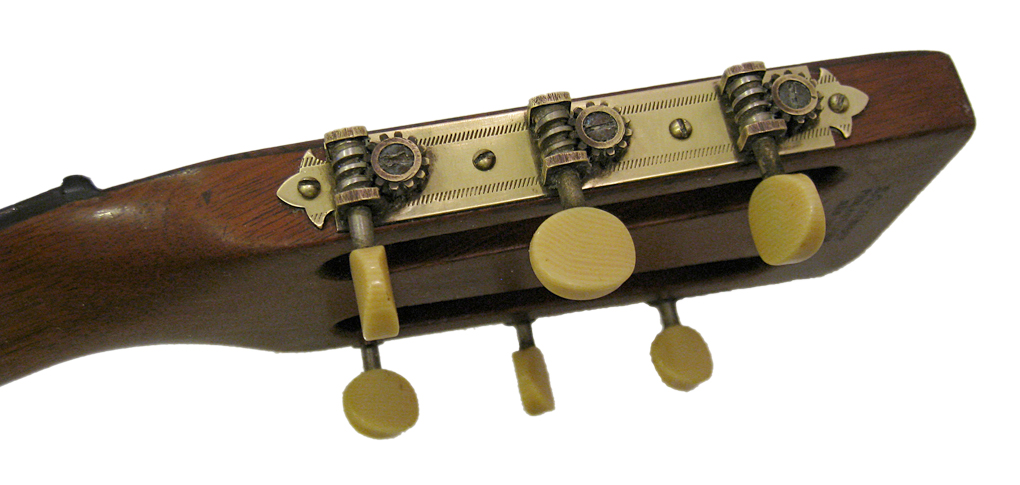
The round-ended Waverly WG-31 tuners began to appear on most Martins in 1925.
The primary structural change that appeared with these tuners is the move away from "reverse gears".
These "modern" tuners can be identified in the photos below by buttons above, or in this case, to the right of the gears.
These Waverly WG-31 tuners with an engraved "Irish Rose" floral design were common on rosewood Martins in the 1920's.
1926 Martin 0-28
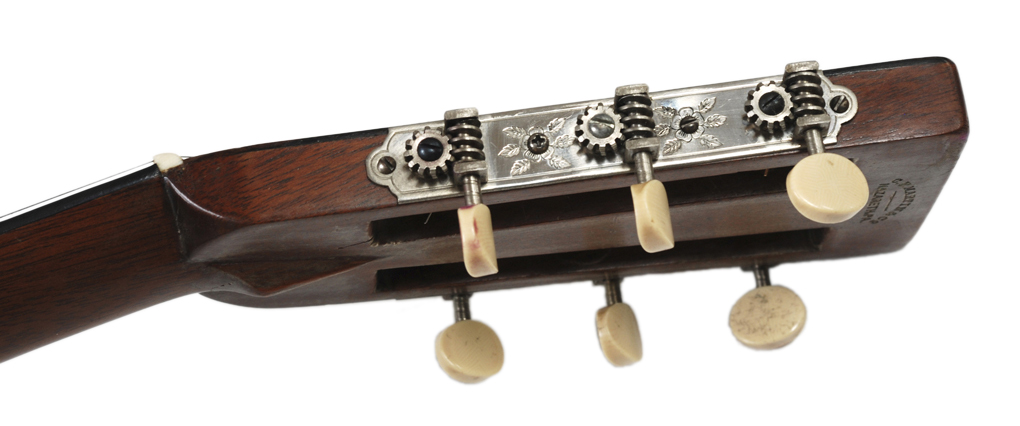
Martin 1926 00-28
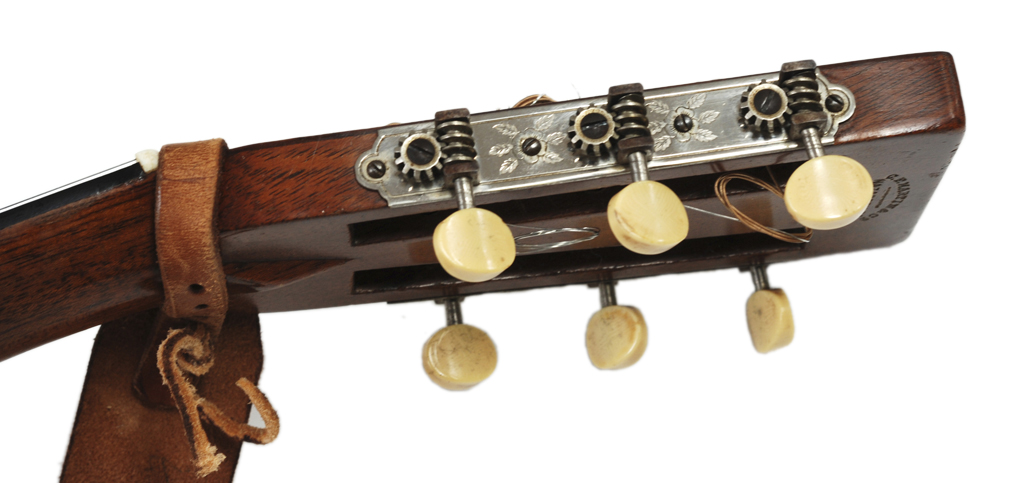
The mid 1920's Style 45 had a more refined version of the Waverly WG-31 with the engraved Irish Rose in Silver
Martin 1925 2-45
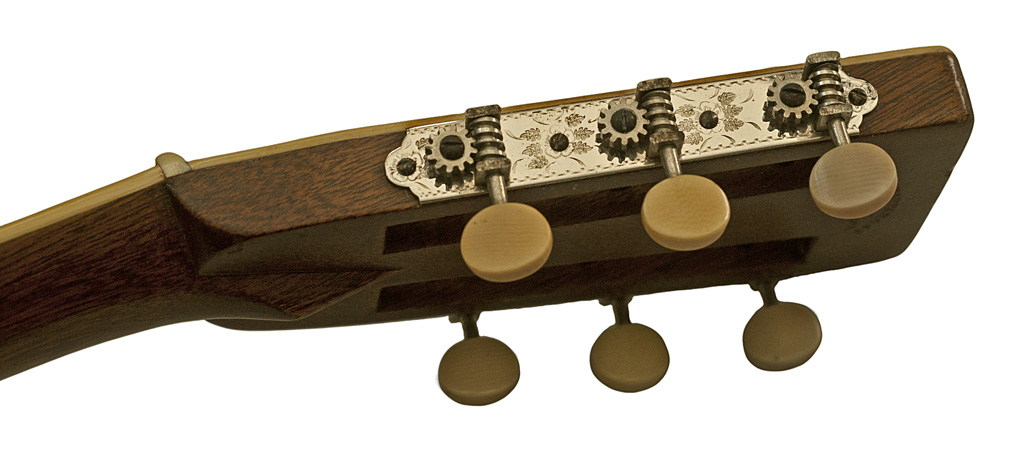
The plain brass Waverly WG-31 tuners with an engraved outline were common on mahogany Martins in the 1920's.
Martin 1927 0-18K
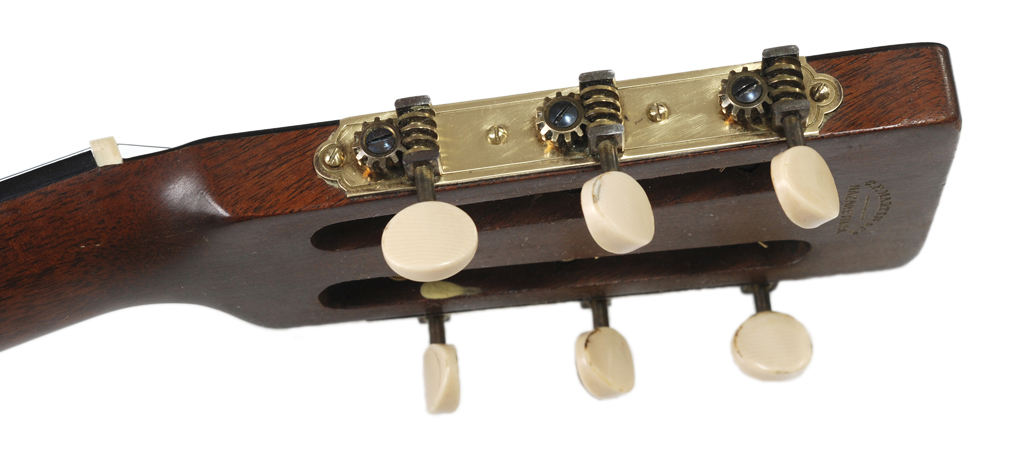
This is one of the less common tuner styles seen on mid 1920's Martins
Martin 1927 000-18
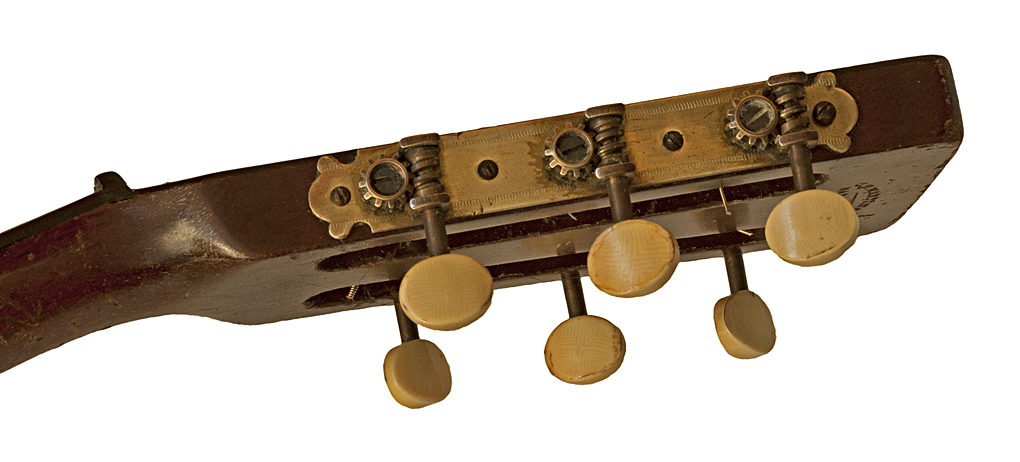
These Waverly WG-31 tuners with an engraved leaf design were also used on better Martins in the 1920's, and were also seen on Gibsons such as the Nick Lucas Model.
1929 000-28
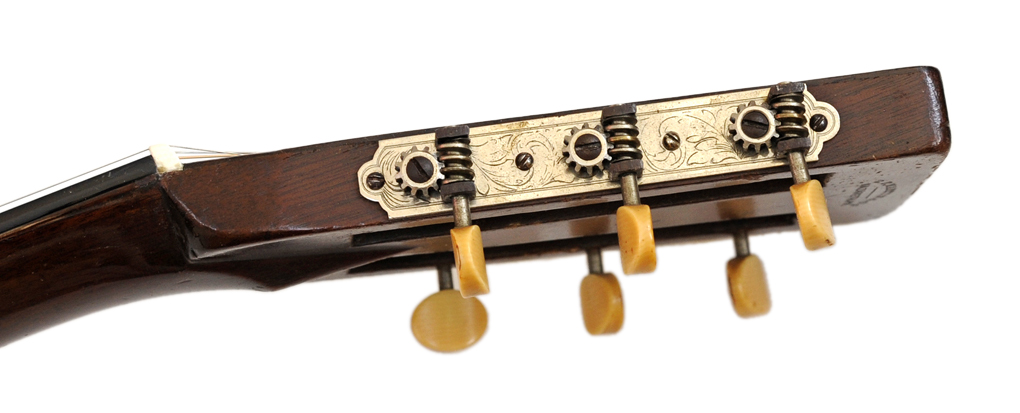
Inexpensive square end machines were used on many guitars built by many makers, and were used by Martin on their less expensive guitars in the 1930's.
Many, if not all of these, are clearly made by Waverly, with the same cogs and screws as on other Waverly tuners of the 20's.
Note that these tuners have "reverse gears".
Martin 1930 2-17
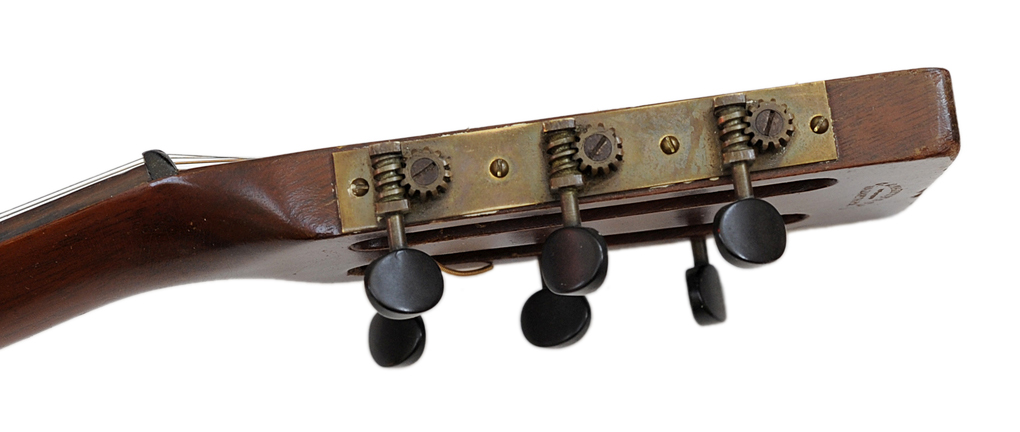
The "Clipped End" Grover tuners of the mid 1930's were most often seen in the form used with Martin's first solid headstocks with machines, but were occassionally seen on 12 fret Martins of the day.
Martin 1934 00-40H
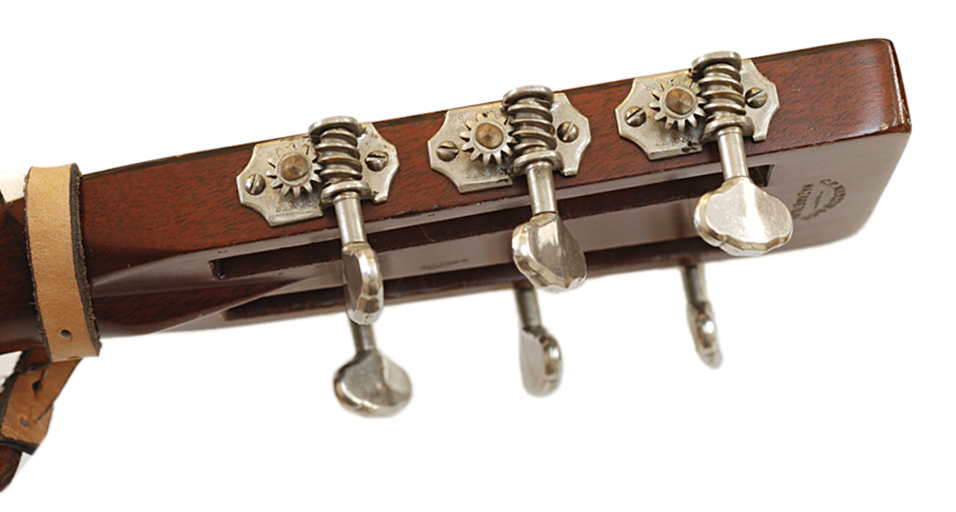
Interestingly, while the old style Waverly tuners seen in the early years of the 20th Century were generally phased out in 1925, they still appeared on some 12 fret Martins, including the 00-18H and some Style 42, until the 1940's. Since very few 12 frets were made in these years, it seems the Martin may have used "leftovers", but you will note that these tuners are not of the reverse gear type, as can be determined by the pegs above the gears.
1941 Martin 00-18H
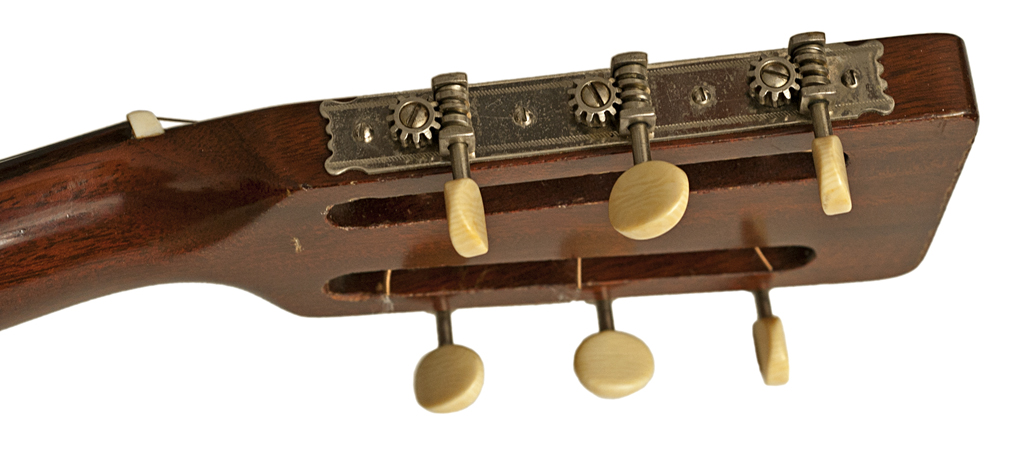
These Grover "open book" tuners are otherwise seen on Gibson guitars, not Martins, but appear on 00-18H from 1937...
